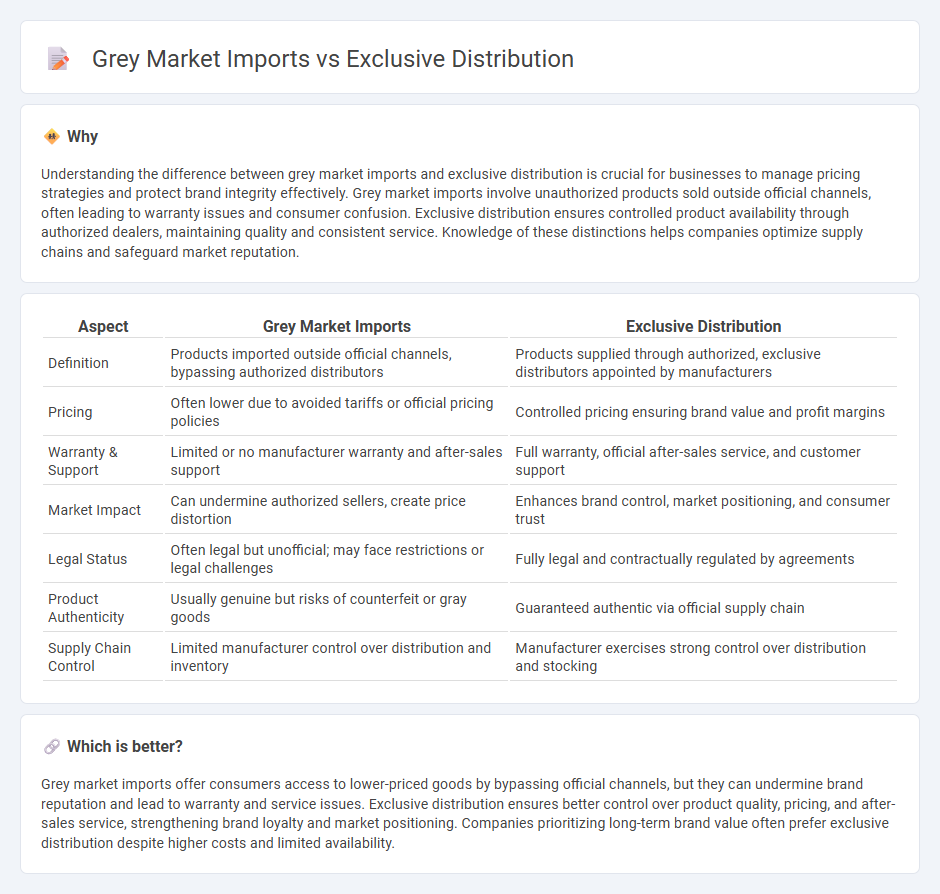
Grey market imports bypass official channels, offering consumers access to products at lower prices but often lacking manufacturer warranties and after-sales support. Exclusive distribution ensures authorized dealers provide genuine products with full manufacturer backing, preserving brand integrity and price stability. Explore deeper insights into how these distribution models impact market dynamics and consumer trust.
Why it is important
Understanding the difference between grey market imports and exclusive distribution is crucial for businesses to manage pricing strategies and protect brand integrity effectively. Grey market imports involve unauthorized products sold outside official channels, often leading to warranty issues and consumer confusion. Exclusive distribution ensures controlled product availability through authorized dealers, maintaining quality and consistent service. Knowledge of these distinctions helps companies optimize supply chains and safeguard market reputation.
Comparison Table
| Aspect | Grey Market Imports | Exclusive Distribution |
|---|---|---|
| Definition | Products imported outside official channels, bypassing authorized distributors | Products supplied through authorized, exclusive distributors appointed by manufacturers |
| Pricing | Often lower due to avoided tariffs or official pricing policies | Controlled pricing ensuring brand value and profit margins |
| Warranty & Support | Limited or no manufacturer warranty and after-sales support | Full warranty, official after-sales service, and customer support |
| Market Impact | Can undermine authorized sellers, create price distortion | Enhances brand control, market positioning, and consumer trust |
| Legal Status | Often legal but unofficial; may face restrictions or legal challenges | Fully legal and contractually regulated by agreements |
| Product Authenticity | Usually genuine but risks of counterfeit or gray goods | Guaranteed authentic via official supply chain |
| Supply Chain Control | Limited manufacturer control over distribution and inventory | Manufacturer exercises strong control over distribution and stocking |
Which is better?
Grey market imports offer consumers access to lower-priced goods by bypassing official channels, but they can undermine brand reputation and lead to warranty and service issues. Exclusive distribution ensures better control over product quality, pricing, and after-sales service, strengthening brand loyalty and market positioning. Companies prioritizing long-term brand value often prefer exclusive distribution despite higher costs and limited availability.
Connection
Grey market imports undermine exclusive distribution agreements by introducing unauthorized products that bypass official channels, causing pricing disruptions and brand dilution. Exclusive distributors rely on controlling supply chains to maintain product scarcity and price stability, which grey market imports directly challenge. This conflict impacts revenue models and market strategies, increasing enforcement costs for rights holders.
Key Terms
Authorized Channels
Authorized channels ensure product authenticity, warranty protection, and compliance with local regulations by strictly controlling distribution through exclusive agreements with certified distributors. Grey market imports bypass these controls, often resulting in unauthorized sales without manufacturer support, risking consumer trust and brand integrity. Explore the impact of authorized channels on maintaining brand value and customer satisfaction.
Parallel Imports
Exclusive distribution restricts product availability to authorized dealers, ensuring consistent pricing and brand control, while grey market imports involve unauthorized parallel imports that bypass official channels, often leading to price discrepancies and warranty issues. Parallel imports exploit price differentials between markets to offer genuine products outside exclusive distribution networks, potentially undermining brand value and authorized reseller profits. Explore the complexities and impacts of parallel imports to understand their effects on global trade and consumer rights.
Intellectual Property Rights
Exclusive distribution ensures authorized sellers maintain control over Intellectual Property Rights (IPR) by limiting product sales to designated regions or retailers, thus protecting brand integrity and preventing counterfeit goods. Grey market imports, however, involve unauthorized reselling of genuine products across different markets, often violating IPR agreements and undermining official distributors. Explore more to understand how these practices impact legal compliance and brand management strategies.
Source and External Links
Strategic Partnerships Through Exclusive Distribution - Exclusive distribution is a strategic partnership where manufacturers authorize select distributors to sell products exclusively within defined territories, helping to protect brand integrity and maintain focused market presence through well-defined agreements.
What is Exclusive Distribution? - Definition | Meaning - Exclusive distribution means a producer grants one or very few intermediaries sole rights to sell in a specific area to improve brand image, maintain prestige, and better control the sales environment and service quality.
Exclusive Distribution Strategy | Definition & Examples - Exclusive distribution is when a company grants sole rights to a distributor within a geographic area, offering benefits such as price and brand image control, often used for high-end products like automobiles and jewelry.
 dowidth.com
dowidth.com